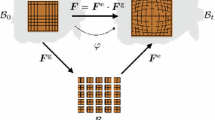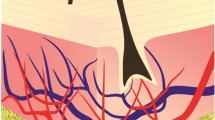Abstract
Skin expansion is the principal technique used in plastic surgery to repair large cutaneous defects, typically after tumour removal, burn care, craniofacial surgery and post-mastectomy breast reconstruction. It allows a gain of new tissue by means of gradual expansion of a prosthesis, surgically implanted beneath the patient’s skin. Nevertheless, wide clinical use is not supported by a deep quantitative knowledge of the phenomena occurring during the expansion. A finite element model of the skin expansion was developed to evaluate the stresses and the strains of the skin due to the expander inflation and validated by proper in vitro experiments; furthermore, a growth model based on the mechanical stimulus was implemented to estimate the skin area gain. The developed computational approach, composed of the skin expansion model interaction and the growth law, proved its validity to investigate skin expansion phenomena: its use suggests a new predictive tool to optimize clinical procedures and the expander devices’ design.
Similar content being viewed by others
References
Bischoff JE, Arruda EM, Grosh K (2000) Finite element modeling of human skin using an isotropic, nonlinear elastic constitutive model. J Biomech 33(6):645–652
Cowin SC (1993) Bone stress adaptation models. J Biomech Eng 115(4B):528–533
Cowin SC (1996) Strain or deformation rate dependent finite growth in soft tissues. J Biomech 29(5):647–649
De Filippo RE, Atala A (2002) Stretch and growth: the molecular and physiologic influences of tissue expansion. Plast Reconstr Surg 109(7):2450–2462
Duffy JS, Shuter M (1994) Evaluation of soft-tissue properties under controlled expansion for reconstructive surgical use. Med Eng Phys 16(4):304–309
Gambarotta L, Massabo R, Morbiducci R, Raposio E, Santi P (2005) In vivo experimental testing and model identification of human scalp skin. J Biomech 38(11):2237–2247
Gibson T, Kenedi RM (1967) Biomechanical properties of skin. Surg Clin North Am 47(2):279–294
Gleason RL, Humphrey JD (2005) Effects of a sustained extension on arterial growth and remodeling: a theoretical study. J Biomech 38:1255–1261
Green AE, Adkins JE (1960) Large elastic deformations and non-linear continuum mechanics. Clarendon Press, Oxford
Hoath SB (1990) Considerations on the role of surface tension and epidermal growth factor in the mechanism of integumental pattern formation. J Theor Biol 143(1):1–14
Holzapfel GA (2000) Nonlinear solid mechanics. A continuum approach for engineering. Wiley, New York
Hudson DA (2003) Maximising the use of tissue expanded flaps. Br J Plast Surg 56(8):784–790
Humphrey JD (1999) Remodeling of a collagenous tissue at fixed lengths. J Biomech Eng 121(6):591–597
Humphrey JD (2001) Stress, strain, and mechanotransduction in cells. J Biomech Eng 23(6):638–641
Humphrey JD, Rajagopal KR (2003) A constrained mixture model for arterial adaptations to a sustained step change in blood flow. Biomech Model Mechanobiol 2(2):109–126
Kirby SD, Wang B, To CW, Lampe HB (1998) Nonlinear, three-dimensional finite-element model of skin biomechanics. J Otolaryngol 27(3):153–160
Lanir Y, Fung YC (1974) Two-dimensional mechanical properties of rabbit skin. II. Experimental results. J Biomech 7(2):171–182
Machida BK, Liu-Shindo M, Sasaki GH, Rice DH, Chandrasoma P (1991) Immediate versus chronic tissue expansion. Ann Plast Surg 26(3):227–231
Maly IV, Lee RT, Lauffenburger DA (2004). A model for mechanotransduction in cardiac muscle: effects of extracellular matrix deformation on autocrine signaling. Ann Biomed Eng 32(10): 1319–1335
Menzel A (2005) Modelling of anisotropic growth in biological tissues. A new approach and computational aspects. Biomech Model Mechanobiol 3:147–171
Mustoe TA, Bartell TH, Garner WL (1989) Physical, biomechanical, histologic, and biochemical effects of rapid versus conventional tissue expansion. Plast Reconstr Surg 83(4):687–691
Neumann CG (1957) The expansion of an area of skin by progressive distention of a subcutaneous balloon; use of the method for securing skin for subtotal reconstruction of the ear. Plast Reconstr Surg 19(2):124–130
Pamplona DC, de Abreu Alvim C (2004) Breast reconstruction with expanders and implants: a numerical analysis. Artif Org 28(4):353–356
Quaglini V, Corazza C, Poggi C (2004) An integrated optical–analytical approach for strain measurement in highly deformable textiles. Adv Exp Mech 514–515
Querleux B, Cornillon C, Jolivet O, Bittoun J (2002) Anatomy and physiology of subcutaneous adipose tissue by in vivo magnetic resonance imaging and spectroscopy: relationships with sex and presence of cellulite. Skin Res Technol 8(2):118–124
Rachev A, Stergiopulos N, Maister JJ (1996) Theoretical study of dynamic of arterial wall remodeling in response to changes in blood pressure. J Biomech 29:625–642
Rachev A (2001) Remodeling of arteries in response to changes in their mechanical environment, CISM lecture notes. Udine, Italy
Radovan C (1982) Breast reconstruction after mastectomy using the temporary expander. Plast Reconstr Surg 69(2):195–208
Reihsner R, Balogh B, Menzel EJ (1995) Two-dimensional elastic properties of human skin in terms of an incremental model at the in vivo configuration. Med Eng Phys 17(4):304–313
Rodriguez EK, Hoger A, McCulloch AD (1994) Stress-dependent finite growth in soft elastic tissues. J Biomech 27(4):455–467
Ruimerman R, Hilbers P, van Rietbergen B, Huiskes R (2005) A theoretical framework for strain-related trabecular bone maintenance and adaptation. J Biomech 38(4):931–941
Schmidt SC, Logan SE, Hayden JM, Ahn ST, Mustoe TA (1991) Continuous versus conventional tissue expansion: experimental verification of a new technique. Plast Reconstr Surg 87(1):10–15
Shelton RM, Chaglassian T (2003) Repair of a large wound of the back, post-Mohs micrographical excision, using chronic skin expansion. Dermatol Surg 29(6):658–661
Shuter ML, Malata CM, Duffy JS, Sharpe DT (1994) Determination of relative contributions of ’mechanical’ and ’biological’ creep in tissue expansion using in vivo pressure monitoring: a preliminary report. Med Eng Phys 16(1):24–28
Silver FH, Siperko LM, Seehra GP (2003) Mechanobiology of force transduction in dermal tissue. Skin Res Technol 9(1):3–23
Taber LA (1995) Biomechanics of growth, remodeling, and morphogenesis. Appl Mech Rev 48:487–545
Taber LA (1998) Biomechanical growth laws for muscle tissue. J Theor Biol 193(2):201–213
Takei T, Mills I, Arai K, Sumpio BE (1998) Molecular basis for tissue expansion: clinical implications for the surgeon. Plast Reconstr Surg 102(1):247–258
Wan Abas WA (1994) Biaxial tension test of human skin in vivo. Biomed Mater Eng 4(7):473–486
Wren TA, Beaupre GS, Carter DR (1998) A model for loading-dependent growth, development, and adaptation of tendons and ligaments. J Biomech 31(2):107–114
Wren TA (2003) A computational model for the adaptation of muscle and tendon length to average muscle length and minimum tendon strain. J Biomech 36(8):1117–1124
Zeng YJ, Xu CQ, Yang J, Sun GC, Xu XH (2003) Biomechanical comparison between conventional and rapid expansion of skin. Br J Plast Surg 56(7):660–666
Author information
Authors and Affiliations
Corresponding author
Rights and permissions
About this article
Cite this article
Socci, L., Pennati, G., Gervaso, F. et al. An Axisymmetric Computational Model of Skin Expansion and Growth. Biomech Model Mechanobiol 6, 177–188 (2007). https://doi.org/10.1007/s10237-006-0047-9
Received:
Accepted:
Published:
Issue Date:
DOI: https://doi.org/10.1007/s10237-006-0047-9




